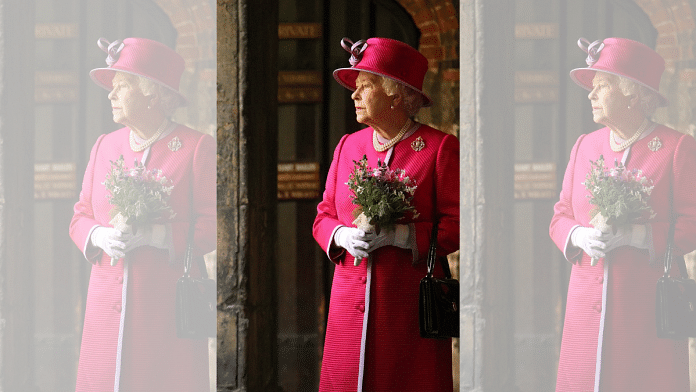New Delhi: As Queen Elizabeth II’s coffin moved towards Wellington Arch in Hyde Park after the hour-long state funeral at Westminster Abbey, a card from her son King Charles III lay atop the funerary box. It simply read: “In loving and devoted memory. Charles R.”
The late monarch, Britain’s longest reigning, was laid to rest Monday after two services – a state funeral at Westminster Abbey, attended by international royalty and world leaders, and a more intimate ceremony at Windsor Castle where she was buried in The King George VI Memorial Chapel – a part of the larger St. George’s Chapel.
After lying in state at the nearby Westminster Hall for four days, the Queen’s coffin was taken around 11 am on a gun carriage to Westminster Abbey for the state funeral. The carriage, last used for the funeral of former Prime Minister Winston Churchill in 1965, was pulled by 98 Royal Navy sailors, with a further 40 marching behind.
The late sovereign was consulted over Monday’s order of service over many years, reports said. It was prepared by the dean of Westminster in conjunction with the Archbishop of Canterbury.
During the state funeral, Prime Minister Liz Truss and the secretary general of the Commonwealth read Lessons or pieces from the Bible.
The service was conducted by the dean of Westminster David Hoyle. The sermon was given by the archbishop of Canterbury Justin Welby, who also gave the Commendation — a prayer which entrusts the soul of the deceased to God.
The Queen vowed on her 21st birthday broadcast that her whole life would be dedicated to serving the nation and the Commonwealth, the archbishop said, adding: “Rarely has such a promise been so well kept.”
Secretary general of the Commonwealth Baroness Scotland read the first Lesson from Corinthians 15, which included the line: “O death, where is thy sting? O grave, where is thy victory? The sting of death is sin; and the strength of sin is the law.”
Liz Truss read the second lesson, taken from John 14. It was one of comfort, “evoking the promise of eternal life in heaven”.
A live radio feed of the funeral played out for the thousands assembled outside.
An hour before the start of the state funeral, the abbey’s falconer Wayne Davis could be seen carrying the falcon Rufus through one of the side rooms of the Abbey, The Guardian reported. The falcon has been patrolling the church since Thursday in an attempt to shoo away pigeons which could have disrupted the service.
From Westminster Abbey, the gun carriage made its way to the Wellington Arch in Hyde Park. The arch, which was initially the original entry to Buckingham Palace, later became a victory memorial commemorating the Duke of Wellington’s defeat of Napoleon.
In front of the Queen’s main residence Buckingham Palace, members of the staff, including chefs, butlers and police officers, had lined up to pay their last respects.
During the last journey, the silence was broken by the occasional toll of church bells and the sound of celebratory artillery fire. The Big Ben tolled continuously.
At Wellington Arch, the Queen’s coffin was transported from the gun carriage to the state hearse. It then made its way to Windsor Palace for the second ceremony of the day.
As the hearse reached Windsor Castle in the evening for the final ceremony, the Queen’s corgis were spotted awaiting the procession. As was her favourite horse, Emma.
There was another procession at the castle grounds by King Charles, Princess Anne, Princes Andrew and Edward and her grandsons Princes William, Harry and Peter Phillips.
The Queen’s coffin was slowly carried up the steps into the St. George’s chapel, in the same path as that of her late husband, Prince Philip a year ago.
The committal service at the castle was conducted by the Dean of Windsor, David Connor.
He began: “Here in St George’s chapel, where she so often worshipped, we are bound to call to mind someone whose uncomplicated but profound Christian faith bore so much fruit, fruit in a life of unstinting service to the nation, the Commonwealth and the wider world.
“But also in kindness, concern and reassuring care for her family, friends and neighbours.”
The scepter, orb and imperial crown – the symbols of sovereignty — was removed from atop the Queen’s coffin and placed at the altar of the chapel during the service.
Minutes before the coffin was lowered into the royal vault, the Lord Chamberlain broke his “Wand of Office” which signaled the end of her reign.
The “Wand of Office” is a thin, white staff and ceremonial tool that was once used to provide discipline to courtiers. It was used by the Lord Chamberlain – the most important position in the royal household, which oversees all departments – to warn courtiers to behave with a tap.
Breaking the wand at a monarch’s funeral signifies the end of Lord Chamberlain’s service to the Queen as sovereign.
The monarch’s coffin was then lowered into the royal vault. The family would return later in the evening to the chapel for a final, private funeral away from cameras.
Also read: ‘Jallianwala distressing example,’ Queen said of ‘difficult’ colonial history on India visit






